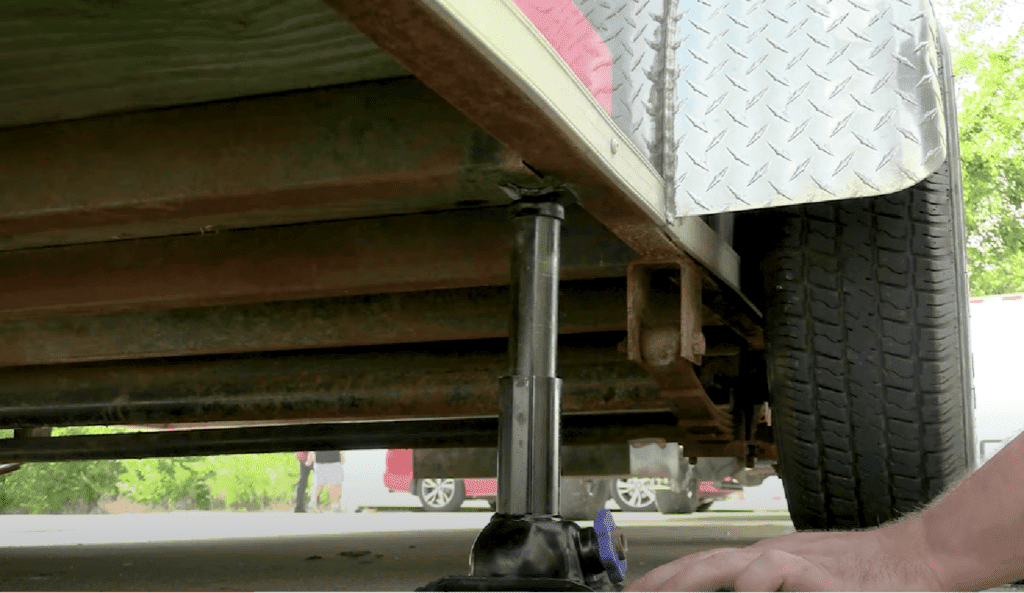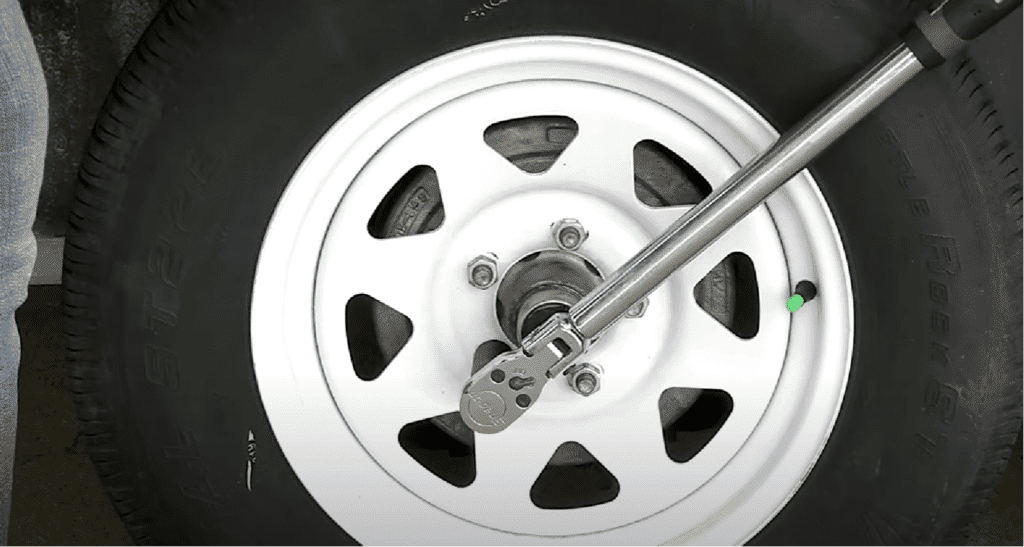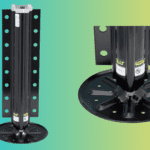To change the trailer tire, you must park on level ground and secure the trailer with wheel chocks. Then, use a jack to lift the flat tire and loosen the lug nuts. After that, remove the flat tire, replace it with a spare tire, and tighten the lug nuts in a star pattern.
Tire blowout accidents are more common and dangerous than you might think. Between 2000 and 2015, tire failure was the cause of one in every 270 crashes. That’s not the worst; in 2017, there were 738 fatalities due to blown tires. The National Highway Traffic Safety Administration (NHSTA) reported these statistics. It is always better to check your tires regularly to eliminate the chance of car accidents caused by tire blowouts, underinflation, and flat tires.
In this article, I present clear, actionable steps you can follow regardless of prior experience. You can easily follow these steps to change a trailer tire successfully. Follow my guide, and you’ll discover you can change your trailer tire like a pro!
Safety First: Before You Begin
Bеforе wе divе into thе nitty-gritty of changing a trailеr tirе, lеt’s talk about safety. Hеrе arе somе еssеntial safety tips:
- Find a safе location: Pull your trailеr off thе road and onto a lеvеl, stablе surfacе. Ensurе you arе in a safе arеa away from traffic.
- Turn on hazard lights: Makе your prеsеncе known to other drivеrs by turning on your hazard lights.
- Usе whееl chocks: Placе whееl chocks bеhind and in front of thе tirеs on thе oppositе sidе of thе flat tirе to prеvеnt any rolling.
- Gathеr your tools: You’ll nееd a lug wrеnch, a jack, a sparе tirе, and glovеs. Ensurе thеy’rе all еasily accеssiblе.
Where’s That Spare?
Now that you’re safe and prepared, let’s find that spare tire. You will usually find the spare tire in one of these three places:
- Under the trailer: Some trailers have a spare tire mounted underneath. You need a crank or a wrench to lower it.
- In the trailer: Check inside your trailer, often in a designated storage area. It may be secured with bolts or straps.
- On the trailer tongue: Occasionally, the spare tire is mounted on the trailer tongue. You can remove it from its holder.
Step By Step Guide
Positioning The Jack
It’s time to position the jack with the spare tire in hand. Follow these steps:
- Locate the jack points: Your vehicle’s owner’s manual will guide you to the appropriate jack points. These are usually along the frame.
- Place the jack securely: Check the jack is on a stable and level surface, and then position it under the jack point.
- Start raising the vehicle: Use the jack handle to raise the trailer slowly. Make sure it’s high enough off the ground to remove the flat tire quickly.

Removing The Flat Tire
Now that you have safely jacked up your trailer, it’s time to remove the flat tire:
- Loosen the lug nuts: Use your lug wrench to loosen the lug nuts. Turn them counterclockwise to loosen.
- Position yourself safely: Stand to the side, not directly in front or behind the tire, as you’ll need to exert some force.
- Finish removing lug nuts: Once loosened, you can now entirely remove the lug nuts by hand. Place them in a safe spot so you don’t lose them.

Replacing With The Spare Tire
With the flat tire off, it’s time to replace it with the spare:
- Position the spare tire: Carefully lift it and place it onto the wheel hub. Line up the holes with the bolts.
- Hand-tighten the lug nuts: Start threading the lug nuts back onto the bolts by hand. This ensures they are aligned correctly.
- Tighten the lug nuts securely: Use your lug wrench to tighten the nuts, but don’t fully tighten them yet. You can do that after lowering the trailer.
Lowering The Trailer
With the spare tire in place, it’s time to lower your trailer:
- Slowly lower the trailer: Carefully turn the jack handle counterclockwise to lower the trailer until it rests on the ground.
- Remove the jack: Once the trailer is on the ground, remove the jack and store it safely.
- Tightening the Lug Nuts
Now that your trailer is safely lowered, it’s time to tighten those lug nuts:
- Star pattern: The lug nuts should be tightened in a star or crisscross pattern. This ensures even pressure and prevents warping.
- Use your body weight: To ensure the lug nuts are secure, use your whole body weight to tighten them with the lug wrench.
- Check and double-check: After initial tightening, go around the lug nuts again to ensure they are appropriately secured.

Storing the Flat Tire and Final Checks
You’ve successfully changed a trailer tire. Now, let’s finish up:
- Store the flat tire: Safely stow it in its designated location or wherever you removed it.
- Check tire pressure: Use a gauge to check the spare tire’s pressure before hitting the road. Inflate or deflate it if necessary.
- Inspect everything: Give your trailer a final once-over. Check all tools are correctly stowed and there are no loose items or any left on the ground.
Image credits: Youtube channel “etrailer.com”
Essentials Of Tire Maintenance
Proper tire maintenance is the key to safe and efficient towing with your trailer. Here are the key aspects you should focus on:
- Tire pressure: Check your tire pressure regularly, ideally once a month. Use a tire pressure gauge and refer to the manufacturer’s recommendations, often found in your vehicle’s owner’s manual or the driver’s door frame. Correct tire pressure ensures optimal handling, fuel efficiency, and tire life.
- Tire inspections: Perform visual inspections of your trailer tires before every trip. Look for any signs of damage, including cuts, punctures, bulges, or cracks in the tread or sidewall. Additionally, check for any embedded objects like nails or rocks. Address any issues promptly, as driving on damaged tires can lead to catastrophic failure.
- Tread depth: Measure the tread depth of your trailer tires regularly using a tread depth gauge. Adequate tread depth is essential for traction, especially in wet or slippery conditions. Replace your tires when the tread depth approaches 2/32 of an inch or less.
- Tire Rotation: To promote even wear, consider rotating your trailer tires according to the manufacturer’s recommendations. Keep in mind that some trailer tire types may not require rotation.
- Alignment: Make sure your trailer’s wheels are correctly aligned. Misaligned wheels can cause uneven tire wear. A professional must check the alignment if you notice your trailer pulling to one side or showing uneven tire wear.
- Balancing: Balancing your trailer tires is crucial to prevent vibrations and uneven wear. This is especially important if you notice any shaking or vibrations while towing your trailer.
Tips To Increase The Lifespan Of Your Trailer Tires
To get the most mileage out of your trailer tires and ensure safe towing, consider these valuable tips:
- Proper inflation: Maintain the correct tire pressure at all times. Underinflation and overinflation can lead to premature tire wear and reduce tire life.
- Load capacity: Avoid overloading your trailer. Exceeding the tire’s load capacity can lead to excessive stress and tire failure. Refer to the load rating information on the tire sidewall.
- Speed limit: Stay to recommend speed limits while towing. High speed generates heat, resulting in tire wear and blowouts.
- Avoid curb strikes: Be careful of curbs and obstacles when moving your trailer. Striking curbs or any other objects can damage the tires, including sidewalls.
- Spare tire check: Always inspect and maintain your spare tire. It should be in good condition, properly inflated, and ready for emergencies.
FAQs
1. How often should I check my trailer tires for wear and tear?
Regularly check your trailer tires before each trip and at least once a month. Look for signs of wear, such as tread depth and visible damage.
2. How tight should I make the lug nuts on the spare tire?
Initially, hand-tighten the lug nuts as much as possible. Then, use a lug wrench to secure them snugly. After you have lowered the trailer, tighten them fully in a star pattern.
3. Can I repair a flat trailer tire instead of replacing it with a spare?
It’s always best to replace a flat trailer tire with a spare. Trailer tires undergo a lot of stress and wear, so using a new spare is the safest option.
4. Do I need to carry any additional tools for a tire change besides the lug wrench and jack?
A pair of gloves, a flashlight, and a tire pressure gauge are the extra tools that will be helpful for a smoother tire change and safety.
5. What should I do if I encounter difficulties during a tire change on my trailer?
If you face challenges or have concerns, it’s best to seek help from a professional or roadside service to ensure safety and proper tire installation.






